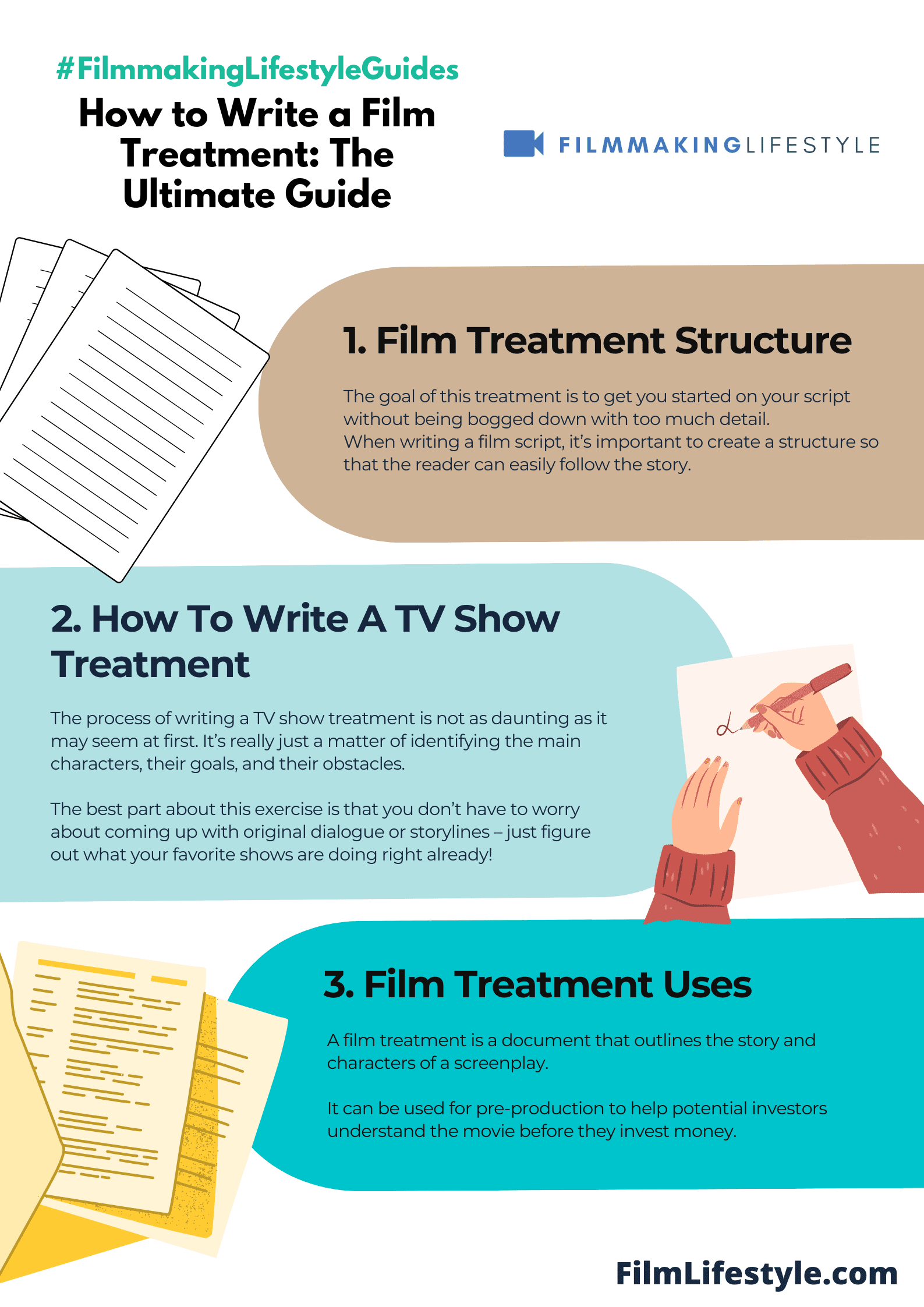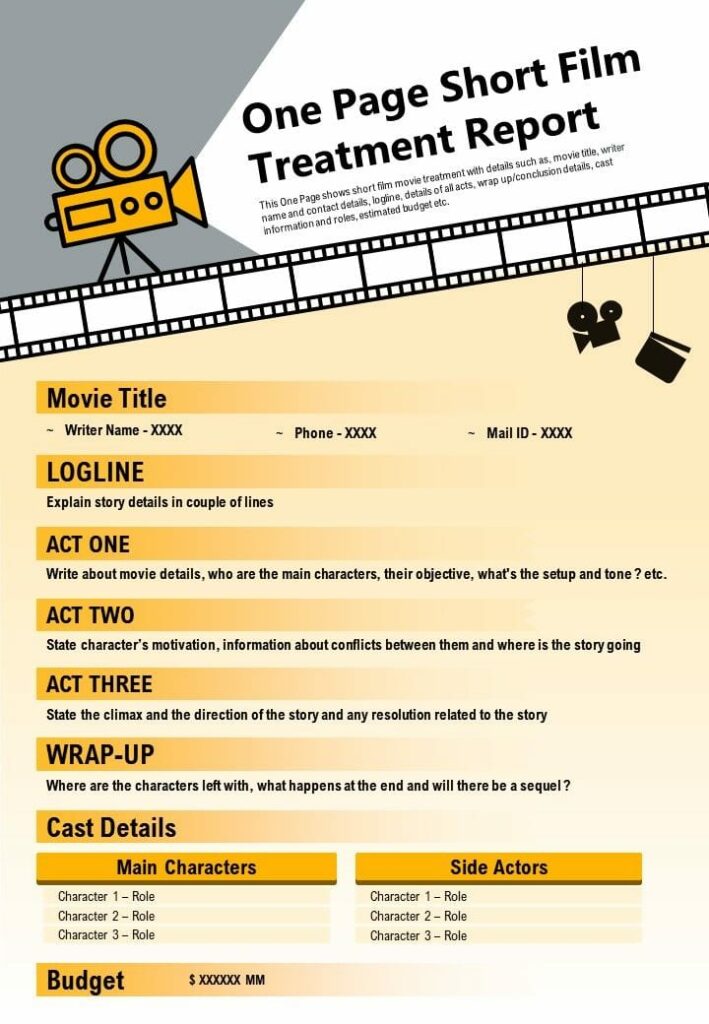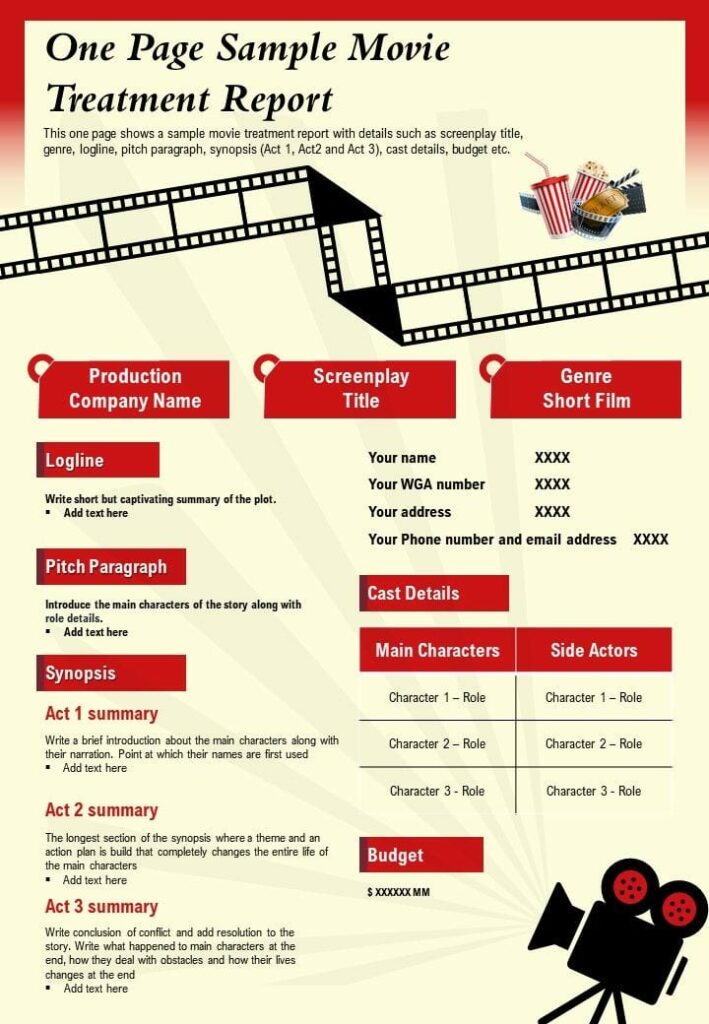So you’d like a way to transmit your idea for a film into an easily digestible format before writing a full screenplay? You need a treatment! But how do you write a treatment for a film?
A film treatment is the first draft of a screenplay, which is typically written in two to five pages and includes both story and characterization.
The purpose of a film treatment is to give the producer (or other readers) an idea of what your story will be like by outlining the basic plot points and themes.
It also gives you time to develop more fully-formed characters before writing out a full screenplay for submission or production purposes.
HOW TO WRITE A FILM TREATMENT
What Is A Film Treatment?
A film treatment is a document outlining the storyline for an upcoming or completed movie.
They are generally briefer than scripts and contain information on what will happen in each scene including dialogue, if necessary.
They may also include things like character descriptions, basic set sketches, and even rough voice-over work to show how scenes might sound with narration.
Ever wondered how filmmakers pitch blockbuster ideas that captivate studio executives?
It all starts with a compelling film treatment.
We’ll guide you through crafting a succinct yet powerful blueprint that lays the groundwork for your cinematic vision.
From outlining your story to setting the tone, we’re here to ensure your treatment stands out in a sea of scripts.
In this article, we’ll break down the essentials of writing a film treatment that grabs attention and paints a clear picture of your project.
Whether you’re a seasoned screenwriter or just starting out, we’ve got the insider tips to help you refine your pitch and get one step closer to the silver screen.
Let’s dive in and turn your idea into a treatment that’s too good to pass up.
What Is A Film Treatment?
A film treatment is a detailed summary of a screenplay written before the actual script.
Think of it as a compelling narrative that showcases the essence of your film’s story, featuring the main plot points, character arcs, and the unique tone and style of the project.
As screenwriters, we use it as a valuable tool to communicate the core of our vision to potential stakeholders like producers or directors, giving them a glimpse into the world we’re creating.
This document typically ranges from 5 to 25 pages and serves as a guideline not just for pitching but also for writing the full screenplay.
It’s meticulous yet flexible, allowing us to map out our story’s trajectory without being overly prescriptive.
A well-crafted treatment can be a screenplay’s best advocate, demonstrating a clear narrative and a deep understanding of the script’s mechanics.
To create a successful treatment, prioritize the narrative’s flow.
Insights about character development, plot dynamics, and scene settings are essential, but so is the readability of the document.
We understand a treatment must be engaging; after all, if we can’t capture attention on paper, how can we expect to do so on the big screen?
Therefore, our treatments are not just blueprints; they’re the first iteration of the story itching to unfold before viewers’ eyes.
Why Are Film Treatments Important?
In the film industry, treatments are crucial for securing funding and getting a project off the ground.
They act as a compelling sales pitch to producers and investors.
A well-crafted treatment conveys the potential of a screenplay, captivating the interest of those who can bring it to life.
Our ability to create an impactful treatment can determine whether a story is picked up or passed over.
Treatments are also fundamental for writers to refine their ideas.
They provide a birds-eye view of the narrative, highlighting strengths and areas that need further development.
As we lay out our story in a treatment, we can critically assess the flow and structure of the narrative, making necessary improvements before drafting the full screenplay.
Moreover, a treatment lays the groundwork for collaboration.
It’s a tool that can be shared with directors, cinematographers, and other key collaborators, aligning everyone’s vision for the film.
By developing a detailed treatment, we ensure that all creative minds involved have a clear understanding of the film’s direction and tone.
Creating a film treatment is about more than just summarizing a story.
It’s about demonstrating our grasp on dramatic structure, character development, and the unique elements that make our screenplay worth investing in.
Through a treatment, we invite others to see the value and depth of our narrative, igniting excitement and anticipation for the film’s realization.
The Key Elements Of A Film Treatment
When we dive into the key elements of a film treatment, it’s essential to focus on its spine: the logline.
A logline is a one or two-sentence summary of your film that highlights the main conflict and gives an idea of the narrative drive.
Think of it as your story distilled to its essence, powerful enough to grab attention.
Next, we must flesh out the synopsis.
This extended narrative outlines the story from start to finish, showcasing a clear beginning, middle, and end.
Unlike the logline, the synopsis provides a more detailed roadmap, describing key scenes and pivotal moments.
It’s not the entire script but it should relay the full journey of the plot and characters.
Character descriptions come next.
Vital to any film treatment, character descriptions offer a snapshot of the protagonists, antagonists, and supporting cast.
They delve into character backgrounds, motivations, and the transformations they undergo throughout the story.
Properly crafting these can help us vividly present the characters before a single frame is shot.
Setting is also
It’s important to convey the world where your story unfolds.
Describe whether it’s a dystopian future, the roaring 20s, or modern-day New York.
The setting not only provides the backdrop but also sets the mood and influences the story’s tone.
Themes and tone can’t be overlooked.
We pinpoint central themes of the screenplay and the tone we envision for the final piece.
Whether it’s hope, love, vengeance, or fear, elucidating themes gives depth to the treatment and aligns the understanding between the writer, producers, and investors.
Visual style is where we paint the picture.
If our film’s look is inspired by the gritty aesthetic of Fight Club or the vibrant palette of La La Land, it should be apparent.
Describing this aspect guides the reader’s imagination and becomes a launchpad for the director’s visual interpretation.
Including key images can be a fruitful addition, as these offer a more concrete visual cue.
They’re snapshots of the most compelling scenes or elements that are pivotal to understanding the film’s aesthetic and emotional impact.
Lastly, we address the unique selling points of the project.
What makes our screenplay stand out in a sea of stories?
It could be an unconventional narrative structure, a plot twist, or a character’s unusual journey.
Clarifying what sets our film apart is crucial to pique interest and secure that ever-important investment.
Crafting A Compelling Story
Building a compelling story is the cornerstone of crafting an effective film treatment.
We know that audiences crave narratives that resonate on a personal level, often those that deal with universal themes or offer unique perspectives.
Our goal is to create a world within the treatment that’s not just believable but also engaging and emotionally impactful.
We ensure that the protagonist is somebody our audience can root for or relate to.
It’s on their journey that the story unfolds, revealing conflicts and character growth that keep the readers – and potential viewers – hooked.
We mold our main character with depth, imbuing them with desires, fears, and flaws that align with the story we’re telling.
As we chart the narrative arc, we’re mindful of its natural ebb and flow.
We craft each act with precision, planting pivotal moments that propel the story forward.
Our aim is to maintain a tension that grips our audience, ensuring that the stakes are high and the outcomes uncertain.
A well-constructed story keeps the reader invested in the characters and their journey.
Tapping into the emotional core of the story is vital.
We explore themes that resonate universally, such as love, loss, or triumph over adversity.
When we intertwine these themes with the plot and character arcs, our treatment takes on a richer, more nuanced texture.
This added dimension helps our story stand out and capture the imagination of its readers.
Visual storytelling is an integral part of our film treatment.
We don’t just tell; we show.
Through vivid descriptions and key images, we paint a picture that’s easy for our readers to visualize.
We give just enough detail to spark the imagination, allowing the story to come alive in the reader’s mind.
This imagery works in tandem with the narrative, enhancing the overall impact of the story we’re conveying.
Setting The Tone And Style
When diving into a film treatment, it’s essential that we capture the essence of the movie’s tone and style early on.
The treatment is a blueprint not only for the narrative but also for how the story feels.
Whether it’s the stark minimalism of No Country for Old Men or the vibrant energy of La La Land, the mood must resonate through every word.
We choose language that evokes the desired emotional response.
Adjectives and verbs are our secret weapons, painting a picture that’s worth a thousand visuals.
If it’s a comedy, we keep the prose light and sparkling with wit.
For thrillers, concise and tense sentences keep the reader on edge.
By clearly defining the genre and intended directorial approach, we give readers an accurate expectation of the final product.
Our treatment reflects whether we’re aiming for a fast-paced action flick or a slow-burning drama.
This approach informs every aspect of the treatment, from character dialogue to the sequencing of events.
Incorporating subtle nods to film techniques can suggest the visual style without delving into technical jargon.
Mention of a lingering close-up or a chaotic handheld sequence conveys a sense of directorial style.
It’s about hinting at the visual palette without stepping into a director or cinematographer’s territory.
Finally, establishing a strong voice is
If our film treatment is for a project akin to The Grand Budapest Hotel, we infuse our writing with the same quirky and meticulous attention to detail that Wes Anderson’s work is known for.
This sets an expectation for the film’s unique storytelling and artistic direction.
Formatting Your Film Treatment
First impressions count, and in the competitive world of filmmaking, a well-formatted film treatment can make all the difference.
Here’s how to ensure your film treatment stands out with its format, as much as its content.
Begin with a clear and concise cover page, including the title of your project, your name, and contact information.
Your treatment’s text should be easy on the eyes, which means ample white space and a readable font like 12-pt Courier or Times New Roman.
Think of your treatment as the bridge between a script and a visual medium.
You’ll want pacing that allows the reader to breathe, digesting each beat of your story without feeling overwhelmed.
Organize your treatment into distinct sections with bold headings.
Consider including an introduction, character breakdown, plot summary, and thematic discussion.
Remember, a visually appealing layout enhances readability.
Employ italics for movie titles and indentations for new paragraphs.
Bullet points can be used to list characters or highlight key elements without bogging down the narrative.
The quality of your writing is
Subheadings for scenes can offer a glimpse into the action, while maintaining a sleek and professional look.
Double-spacing between paragraphs gives your treatment the structure it needs to guide readers through your envisioned world seamlessly.
Our treatment is the ambassador of our vision, paving the way for what’s to come on the screen.
It deserves the same meticulous attention to detail as every facet of our filmmaking process.
Effective formatting isn’t just about aesthetics; it’s about showcasing our story in the clearest, most engaging way possible.
Tips For Writing An Effective Film Treatment
As we delve deeper into crafting an effective film treatment, it’s crucial to recognize that preparation is key.
Before you write a single word, have a clear storyline and know your characters inside and out.
This foundational work will make the entire process smoother and ensure your treatment is coherent and compelling.
Your film treatment should feel like a gripping narrative.
Even though it’s a condensed version of your script, it’s essential to engage your reader immediately.
Start with a strong hook that captures the essence of your film – think of it as the elevator pitch that will get readers invested from the beginning.
Focus on your logline and synopsis.
These elements are arguably the backbone of your treatment, providing a snapshot of your story’s premise and scope.
Ensure the logline is tight and the synopsis expands on it, illustrating the main plot and character arcs without excess detail.
Visual storytelling can be enhanced with selective use of imagery.
While your treatment isn’t a storyboard, including evocative images can help convey the tone and style of the film.
Just remember, the primary focus should remain on the written content.
Maintain readability by using active voice and present tense throughout.
Write with confidence and clarity, and remember that your treatment is also demonstrating your writing ability.
Avoid passive constructions and maintain tension just as you would in the script itself.
Structure is your friend, so embrace bold headings and bullet points to organize your content.
Your aim is not only to tell your story but also to make it easy for producers and executives to understand and remember the key points.
Keep in mind that we’re striving to create a treatment that stands out for its professional quality and storytelling flair.
With these tips, we’re empowering filmmakers to present their vision in a manner that’s both accessible and exciting for potential collaborators and investors.
How To Write A Film Treatment – Wrap Up

Crafting a film treatment that captures the essence of your story is crucial in the filmmaking process.
We’ve shared our best tips to ensure you’re prepared with a clear narrative and dynamic characters.
Remember, it’s all about creating a compelling read that showcases your vision.
Stick to an active voice and present tense to keep the treatment lively and engaging.
Organize your ideas with bold headings and bullet points for easy readability.
With these strategies, you’re well on your way to presenting a treatment that’ll make a lasting impression and take your script to the next level.
Now, it’s time to bring your cinematic story to life!
Frequently Asked Questions
What Is A Film Treatment?
A film treatment is a detailed, narrative description of a film’s story, characters, and major plot points, often written to give readers a preview of the film’s potential before the screenplay is completed.
How Long Should A Film Treatment Be?
Film treatments can vary in length, typically ranging from 5 to 25 pages, depending on the complexity of the story and the intended use of the treatment.
What Are Key Elements To Include In A Film Treatment?
Key elements of a film treatment include a clear storyline, well-developed characters, a compelling hook, a concise logline and synopsis, and selective imagery to bolster visual storytelling.
How Can I Make My Film Treatment Engaging?
Make your treatment engaging with a strong hook to capture interest, use active voice and present tense for readability, and include bold headings and bullet points to organize sections clearly.
Should A Film Treatment Include Visual Elements?
While the primary focus should be on written content, using selective visual imagery can enhance the reader’s understanding of the story’s visual style and tone without overwhelming the text.
What Is The Best Tense And Voice For Writing A Film Treatment?
The best practice for writing a film treatment is to use an active voice and present tense to create a sense of immediacy and keep the reader engaged with the unfolding story.
How Can I Make My Film Treatment Stand Out?
To make your film treatment stand out, focus on delivering professional quality writing with a unique storytelling flair, ensuring that your pitch is not only clear and well-organized but also compelling and memorable.



Matt Crawford
Related posts
6 Comments
Leave a Reply Cancel reply
This site uses Akismet to reduce spam. Learn how your comment data is processed.



This is a great guide! I’m a first time filmmaker and this has been a great help.
Thanks!
This is a great guide! I’m a first time filmmaker and this has been a great help.
Thanks, Chris.
I found this post incredibly informative and helpful in understanding the process of writing a film treatment. The clear and concise instructions made it easy to follow along and apply the tips to my own writing. Can’t wait to start working on my own film treatment with the knowledge gained from this post!
Thank you